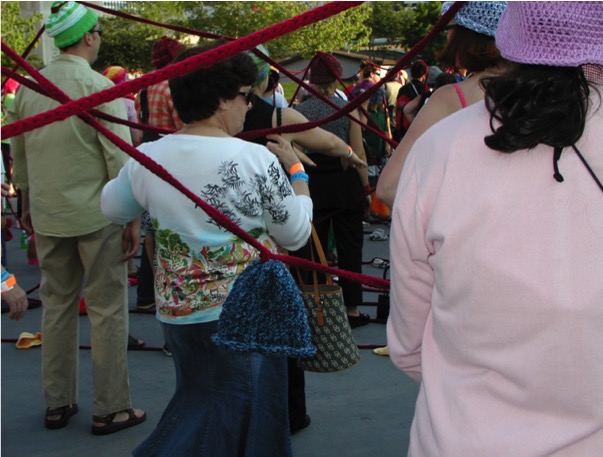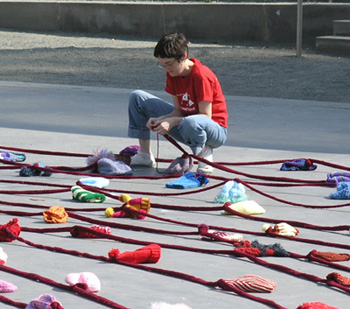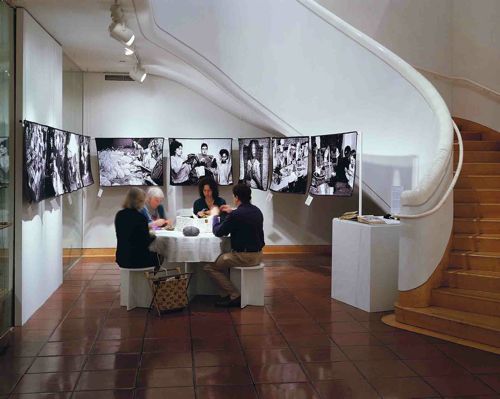
The Red Thread Project, Grand Rapids, MI, 2006. Photo by Eve Jacobs-Carnahan.
Knitting is participation.
In her essay “Knitting is . . .” artist Sabrina Gschwandtner describes the many forms that knitting takes in life and art. Journal of Modern Craft, v.1:2 (2008). One of them is participation. Participatory knitting projects create community artworks and connections.
Participating is caring
My first encounter with knitting as a community art form was with the Red Thread Project. Artist Lindsay Obermeyer organized this project to dramatize the ways people are interconnected. She was inspired by a Chinese proverb that says: “An invisible red thread connects those who are destined to meet regardless of time, place or circumstance. The thread may stretch or tangle, but it will never break.”
Obermeyer recruited participants to knit hats for cancer patients, foster children, the elderly, and homeless people. Before distributing the hats to the recipients, she attached them to a ½-mile long red knitted cord. At a culminating event, people gathered in a city plaza, donned the hats, and moved in a simple circle dance designed to feel their interconnections. I slipped into one of the hats on the plaza in Grand Rapids, Michigan, and felt the force of community.

Lindsay Obermeyer, The Red Thread Project, photo by Samantha Bennett.
Participating is learning
The most ambitious participatory knitting project that I know of is the Crochet Coral Reef project. Okay, it’s actually not knitting, but it’s illustrative of the idea. This massive endeavor began on a lark when sisters Christine and Margaret Wertheim had the idea of crocheting replicas of corals. Christine and Margaret, artist and scientist, respectively, sought to bring attention to the ways climate change is destroying the Great Barrier Reef. What began as a whim grew to an international art project as nearly 8,000 people in dozens of countries crocheted hyperbolic structures from every type of yarn imaginable.

Crochet Coral Reef (detail) as displayed at the Museum Kunst der Westkust on the island of Fohr in the North Sea, 2012. ©Institute for Figuring.
No single knitter could have created these large installations alone. Crowdsourcing the work was key to expanding the workforce. It also added to the variety of coral shapes and colors. Enlisting participation became a means of teaching people about the degradation of coral reefs. Everyone who participated became an emissary of information about this environmental problem.
I recently saw several pieces of the project’s re-imagining of coral created from plastic trash at the Smith College Museum of Art. Though whimsical and full of color, these creations highlight the effects of plastic on ocean life.

Chthulucene Anemone by Christine Wertheim in Plastic Entanglements exhibition at Smith College Museum of Art, Northampton, MA. Photo by Eve Jacobs-Carnahan.
Participating is conversation
In Gschwandtner’s article about knitting, she observed that knitting gatherings create “sites of conversation” where “collective crafting and dialogue could be part of the art experience.” As participants sit and engage their hands, they talk with each other. Gschwandtner created such an in-person participatory experience with her “Wartime Knitting Circle,” an interactive installation at the Museum of Arts and Design in 2007.

Wartime Knitting Circle, 2007, installation by Sabrina Gschwandtner at Museum of Arts and Design, New York, NY. Photo by Alan Klein.
Museum visitors sat and knit squares for photo-blankets, like those hanging on the walls in the alcove where they sat. Their participation completed the knitting circle. By creating this space for knitting, the artist encouraged conversation about the wars in Iraq and Afghanistan.
Knitting is participation.
Fascinating blog essay, Eve. Such an engaging and needed characteristic in our sometimes unconnected world.
I have a graduate student who’s doing her thesis on just this topic. Particularly for women. I will send her your post. I just love that coral reef- fable-ous.
I’d love to read her thesis when she’s done.